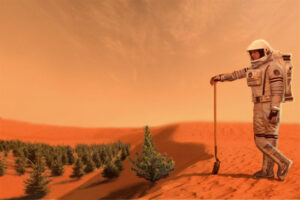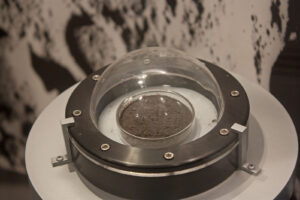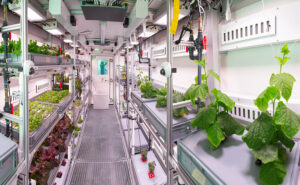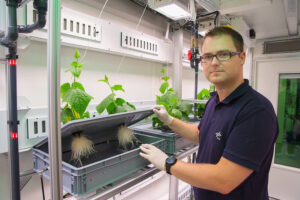by Alwyn Saju

Figure 1: Colonization of Mars, credit: D Mitriy (CC BY-SA 3.0) via Wikimedia Commons.
A scenario shown in the above figure is too challenging to be realised. In future human space exploration missions, our astronauts will face many food challenges when visiting exotic places like the Moon and Mars. Luckily, space engineers and scientists are working on technologies to solve the challenge of growing fresh food in space. In this article you will read about such technologies and understand how farming in space will be really done.
Let us begin with a question: How do astronauts get food during space missions? Let’s find out.
Food scenario in human space exploration missions
Currently the most familiar and frequent crewed missions to space are visits to the International Space Station (ISS) to carry out various scientific experiments and maintenance work of the space station. You might have already watched many interesting videos of astronauts in ISS showing their food items floating around in microgravity condition. Most of these foods are packed and freeze-dried foods which are prepared and brought from earth (see figure 2). Astronauts in these missions are dependent on resupply missions which bring food and other things for their need.

Figure 2: Food for American astronauts on board of the ISS (exhibited at Euro Space Center in Belgium), credit: NearEMPTiness (CC BY-SA 4.0) via Wikimedia Commons.
Launching something to space is a costly task and these resupply missions will add up the cost of crewed mission. The ISS is about 400 km above the Earth’s surface and it is very near compared to other destinations in space. The time and money spend for resupply missions to these destinations will be even more and is undesirable.
Extra-terrestrial destinations planned for human space exploration in the near future are our Moon and the planet Mars. The goal is to build bases there to carry out exploration activities. In such long duration missions, astronauts cannot solely depend on packed food from Earth. The solution is to grow fresh foods on these destinations. During the initial period of exploration and settlement when the resources are limited, “pick and eat crops” like leafy green and high-water content fruits and vegetables are ideal. They do not require post processing.
Lunar and Martian terrains are similar to arid, barren lands like deserts found on Earth. Can we use lunar regolith (fine mix of dust and small rocks that covers the moon surface, see figure 3) or Martian soil for farming? There are many studies and investigations on this topic but several challenges like toxicity, soil fertility, handling difficulties etc. need to be addressed.

Figure 3: Lunar Regolith 70050 sample, collected from the Moon by the Apollo 17 mission, on display in the National Museum of Natural History, credit: Wknight94 talk (CC BY-SA 3.0) via Wikimedia Commons.
Then how can we farm in these exotic places where the environment is unsuitable and resources for agriculture are unavailable? Let’s check out an alternative agricultural method that solves our problem.
Controlled Environment Agriculture.
If the environment is not suitable for growing plants, we create an artificial environment by using systems that maintain suitable conditions for growth and provide the required resources for the plants. That’s what done in Controlled Environment Agriculture (CEA). This modern agricultural technique is also practiced in greenhouses built on Earth and will be adopted in future habitats in space. One such experimental greenhouse module is in Antarctica operated by EDEN ISS, an international research group working on the advancement of CEA technologies for application in space.

Figure 4: The ‘Future Exploration Greenhouse’ in EDEN: ISS greenhouse, credit: DLR (CC-BY 3.0).
Plants need CO2, water, light and nutrients; accordingly, CEA consists of different systems:
Atmosphere Management System (AMS)
As the name suggests, this system manages the atmospheric conditions around the plants. The main tasks of AMS include air circulation, water recovery, temperature and humidity adjustment. Furthermore, it can modify the composition of air and carry out filtration. Each hardware in the AMS is involved in one of these tasks. As plants give out water through the tiny holes called stomata on their leaves (the process is called transpiration), the humidity in the grow chamber (where the plants grow) increases. Therefore, water should be extracted from the air stream time to time. Low humidity level is not suitable for plants but very high humidity level hinders transpiration and mineral uptake. Since plants need CO2, this must be injected into the system (in space habitats, exhaled air from astronauts could be supplied to plants and O2 given out by plants could be used by astronauts).
Interestingly, a little higher CO2 concentration in greenhouse than the normal level on Earth is beneficial for plant growth.

Figure 5: Inspecting various hardware in EDEN: ISS greenhouse, credit: DLR (CC-BY 3.0).
Nutrient Delivery System (NDS)
Plants need water for photosynthesis and essential micronutrients (like Zinc, Iron, Sodium etc.) and macronutrients (Nitrogen, Calcium, Phosphorus etc.) for nutrient uptake. An adequate mixture of nutrients and water is made in the mixing unit and provided to the roots of the plants. This nutrient solution should be free from pathogens and unwanted particles and should have adequate salinity and pH level (pH is the measure of acidity of a solution). Different irrigation methods are utilized. One very interesting technique is aeroponics (shown in figure 6). Here, plants don’t need soil and the nutrient mixture is sprayed directly on the roots. The water should be enriched with dissolved O2.

Figure 6: The aeroponic system for plant cultivation in the EDEN: ISS greenhouse, credit: DLR (CC-BY 3.0).
Illumination Control System (ICS)
Photosynthesis requires light. On Earth, plants receive sunlight. The task of ICS is to provide plants with adequate light exposure and light duration. There are specific light spectrums to which plants show more sensitivity for photosynthesis. Adequate light mix can also influence plant’s health. Various illumination technologies are used such as natural lighting, artificial systems like fluorescent or LED lamps (figure 7 and 8) and hybrid systems.

Figure 7: Tomato plants are growing under red and blue LED lights in a growth chamber inside a laboratory at the Space Station Processing Facility at NASA’s Kennedy Space Center in Florida. Original from NASA. Digitally enhanced by rawpixel, credit: Rawpixel Ltd (CC BY 2.0).

Figure 8: LED-lit mustard plants in the EDEN: ISS greenhouse, credit: DLR (CC-BY 3.0).
Conclusion
Food is an integral part for survival and future space habitats without greenhouses employing CEA technologies is unimaginable. These greenhouse modules will be sent to their destinations even before the astronauts start their journey for long duration exploration or settlement.
People back on Earth can also benefit from these technologies through their terrestrial application. The next article awaits to introduce you one such application, an interesting project called MEPA. Go check it out!
These topics are discussed in the “Human Space Exploration and Habitation” lectures for MSc. Space Engineering programme at the University of Bremen. In these lectures, the lecturers share first-hand research experience in their field and students learn about challenges of long duration crewed missions, interesting research projects, technologies and concepts for future exploration activities and space habitats.
More about EDEN ISS: https://eden-iss.net/
Image sources:
1. https://commons.wikimedia.org/wiki/File:Colonization_of_Mars.jpg#filehistory
4. https://www.flickr.com/photos/dlr_de/35307102170
5. https://www.flickr.com/photos/dlr_de/39602172822/in/album-72157683682719480/
6. https://www.flickr.com/photos/dlr_de/34853306544/in/album-72157683682719480/
7. https://www.flickr.com/photos/vintage_illustration/32490334308








Leave a Reply